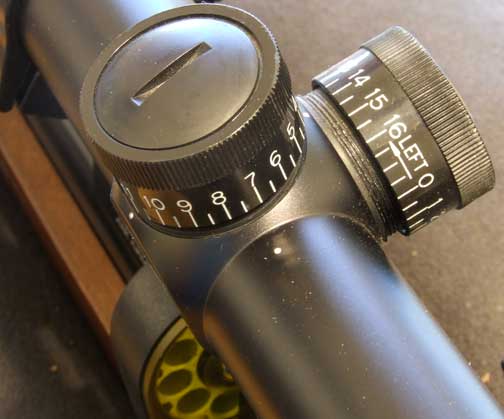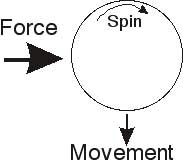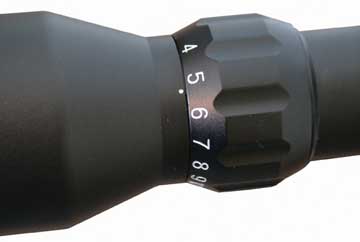by Tom Gaylord
Exclusively for PyramydAir.com. Copyright 2008. All Rights Reserved.
There are several standard problems with scopes, and I'm going to address two common ones in this article. Let's get right to it.
SCOPE SHIFT
This is the No. 1 problem shooters have with scopes. It's also called point-of-impact (POI) shift. There are several reasons for this and none of them are the scope's fault. They're problems that plague mostly new scope users, but they can also crop up when a veteran shooter starts using a scope in a new way. The reasons for scope shift are many, so I'll try to rank them by the commonality of occurrence.
FOR SPRING GUNS ONLY: For spring guns, the No. 1 cause of scope shift is how the gun is held. Certain spring guns are so sensitive that the group impact point can be moved several inches at close range, depending on where the hands are placed and how the stock is held. The reason for this is the vibration patterns that spring guns have when they shoot. Other powerplants don't have these vibrations and cannot react to them. If you own a spring gun and don't hold it exactly the same way for every shot, you can expect poor accuracy and scope shift all the time. The solution is to develop one hold and memorize it so you always apply it.
1. Parallax
This is generally the most common cause of "scope shift" for all air rifles (with the exception of hold sensitivity for spring guns, mentioned above). I put the quotes around the phrase, because it isn't the scope that is shifting...it's the shooter! New shooters see that their scope has a parallax correction adjustment (the AO wheel) and they assume that once they're focused on target there's no more parallax. That's incorrect. Parallax is the line between your eye, the reticle and the target. Because the three are in different planes, there MUST always be some parallax. A good scope can reduce this to a large extent, which for some shooters is all it takes. Does a deer hunter care whether the bullet passed between the third and fourth ribs or just broke the third rib? As long as the deer is down, that's the whole point. But, a field target shooter gets upset when his pellet lands 0.04" from where he intended. The deer hunter will never notice parallax; the field target shooter will obsess over it.

The adjustable objective, or AO, removes as much parallax as possible at any given range. The shooter just turns the adjustment ring on the objective bell until the target is as sharp and clear as it can get. As good as it is, AO doesn't remove any of the parallax caused when the shooter places his aiming eye at different places in relation to the eyepiece. A repeatable spotweld that always locates the aiming eye in the same place is necessary.
To correct the kind of parallax I'm talking about, the shooter has to be 100 percent certain that he places his eye at the same location for every shot. This is called a "spotweld" by the U.S. Army, which refers to assuming a position so regular that it's as if your head were spotwelded to the gun. This most-common cause for scope shift is 100 percent user-caused and can therefore be entirely prevented.
2. Elevation adjusted too high
The second most common cause for scope shift is when the vertical reticle is adjusted too high. The reticle is etched on a tube called the erector tube. When adjustments are made, the entire erector tube moves. A spring opposite the vertical adjustment knob keeps tension on the erector tube. On many scopes, this spring relaxes when the elevation is adjusted too high. I call it "floating" the erector tube, because that's what's happening...the tube is floating at the end of the spring travel. The erector tube is no longer held rigidly between the spring and the adjustment screw, and it hops around from shot to shot, taking the rifle's aimpoint with it.

When the elevation knob (top) is adjusted up too high, the scope's erector spring relaxes and allows the erector tube to float instead of holding it tightly in position. Groups can shift from this.
This situation is entirely correctible by not adjusting the reticle too high. You can feel when the erector tube spring starts to relax, and in most scopes the adjustment detents (the clicks) start to sound mushy and indistinct. On other scopes, the detents are mushy at all ranges, and this cue cannot be relied upon.
3. Shooting at different ranges
This one is so common, yet so deviously subtle at the same time. Most shooters figure if they mount a scope on a rifle and level the horizontal reticle, the shot groups will adjust straight up or down when the scope's elevation is changed. No, they won't! In fact, they'll almost never do this without something being done to the scope first. That something is called optical centering of the reticle.

All three groups of five shots were fired with the same aimpoint - the center of the bullseye! The scope was zeroed at 20-30 yards. The group at 10 yards is low and to the right of the vertical reticle that passes through the center of the bull from 12 o'clock to 6 o'clock. The group at 40 yards is lower and to the left of that line. This scope was not optically centered, so the groups do not stay on the vertical reticle. If the scope were adjusted up so the groups would be at the correct elevation, they would still fall on either side of the centerline.
The barrel of a rifle almost never looks in the same direction as the scope. The difference is usually too small to see, but it's there. If you zero the rifle for 20 yards, the groups will be LOW AND TO THE RIGHT at 10 yards and LOW AND TO THE LEFT at 40 yards! (Note: It can also be just the opposite - left and right.) You can re-zero the scope all day long - this relationship will never change. Some people will remount their scope, then they switch with other rings, then they swap the rear rings for the front, all in a vain attempt to correct what is easily corrected by optically centering the scope. Read this blog posting to learn how to optically center a scope.
4. Cant
Canting a gun is a common reason for small amounts of scope shift. If your groups are moving 0.50" to 0.75", then cant could be involved. It's usually associated with large group sizes rather than scope shift; but, if you're shooting a tackdriver, it can look like scope shift. Cant means tilting the rifle to one side or the other. You're tilting with respect to the angle at which the gun was sighted-in. Canting is entirely correctible with a scope level, and I like the B-Square level best because it sticks out to the side and it's ambidextrous.
5. Sidewind
A sidewind will blow your pellet in the direction the wind is blowing, and also either up of down, depending on the wind direction and the direction of spin imparted by your barrel. This is caused by a phenomenon known as precession. A gyroscope (your spinning pellet) that's pushed in a certain direction will move at 90 degrees to the force. The movement will always be in the direction of spin. If the gyro is spinning in a righthand direction and you push it to the right, it doesn't go right...it goes down. Push to the left and the same gyro doesn't go left. It goes up. The gyroscope is touching the earth at its point where a lot of friction holds it fast. A pellet flying through the air has no friction holding it in place, so it tends to go with the flow. Therefore, the sideways movement is usually larger than the upward or downward movement.

Precession causes a gyroscope to move 90 degrees to the direction of force in the direction of spin.
6. Changing the scope's power
When the power is increased or decreased on some variable scopes, the point of impact can change. Apparently, it depends on how the lenses are arranged inside the scope. This used to be a common problem, but a lot of scope manufacturers have designed their scopes so it doesn't happen as much anymore. I shoot a lot of Leapers scopes, and I've never seen a POI change when the power was adjusted on one of them.

Variable-power scopes are common today. Most of them retain their zero when the power is adjusted, but not all of them.
7. Changes in temperature
This is a very minor cause of scopes shifting, but it can affect you suddenly and with no warning. You sight in your rifle in August when the temperature is 85 degrees. It remains on target through November, even though the temp has dropped back to 60 degrees during a fine Indian Summer. Then, one crisp day in early December, you go squirrel hunting on a day when the temp starts out at 28 and drops to 18. Your rifle can't hit a barn wall...from the inside! The temperature has contracted the optical mounts in the scope and caused them to move, and there's nothing to do about it be sight-in again.
BARREL DROOP
A barrel droops when it points downward in relation to the scope. This is very common with spring guns, and not unheard-of with PCPs and CO2 gun. While breakbarrels droop, so do sidelevers and underlevers - which surprises many shooters.
The common solution to barrel droop is also the wrong one. Shooters simply adjust the elevation up on their scopes, float the erector tube and get into problem No. 2, described earlier.
Instead, they should install a good, adjustable scope mount that can be set higher in the back than in front. Read about adjustable scope mounts in a Pyramyd Air blog entry. I'll be writing another article about how to install and adjust B-Square scope mounts in the near future.

Buy With Confidence
Get FREE shipping on qualifying orders! Any order $150+ with a shipping address in the contiguous US will receive the option for free ground shipping on items sold & shipped by Pyramyd AIR during checkout. Certain restrictions apply.
Free shipping may not be combined with a coupon unless stated otherwise.
View Shipping Info
We work hard to get all orders placed by 12 pm EST out the door within 24 hours on weekdays
because we know how excited you are to receive your order.
Weekends and holiday shipping times will vary.
During busy holidays, we step our efforts to ship all orders as fast as possible,
but you may experience an additional 1-2 day delay before your order ships.
This may also happen if you change your order during processing.
View Shipping Times
It's important to know that due to state and local laws, there are certain restrictions for various products. It's up to you to research and comply with the laws in your state, county, and city. If you live in a state or city with regulations, you may be able to take advantage of our special FFL program.
U.S. federal law requires that all airsoft products be sold with a 1/4-inch blaze orange muzzle or an orange flash hider to avoid being mistaken for regulated products.
View Shipping Restrictions
Get the most out of your equipment when you work with the expert technicians at Pyramyd AIR. With over 25 years of combined experience, we offer a range of comprehensive in-house services tailored to kickstart your next adventure.
We can test and adjust your equipment in our Pro Shop before shipping, so you receive a product that's ready to perform right out of the box. We can even set up an optic or other equipment so you can get out shooting without the hassle. For bowhunters, our certified master bow technicians provide services such as assembly, optics zeroing, and full equipment setup, which can maximize the potential of your purchase.
By leveraging our expertise and precision, we ensure that your equipment is finely tuned to meet your specific needs and get you ready for your outdoor pursuits. So look out for our services when shopping for something new, and let our experts help you get the most from your outdoor adventures.
View Service Info
Shop and purchase with confidence knowing that all of our products (except airsoft) are protected
by a minimum 1-year manufacturer's warranty from the date of purchase unless otherwise noted on the product page.
A warranty is provided by each manufacturer to ensure that your product is free of defect in both materials and workmanship.
View Warranty Details
Didn't get what you wanted or have a problem? We understand that sometimes things aren't right and our team is serious about resolving these issues quickly. We can often help you fix small to medium issues over the phone or email.
If you need to return an item please read our return policy.
Learn About Returns
Get FREE shipping on qualifying orders! Any order $150+ with a shipping address in the contiguous US will receive the option for free ground shipping on items sold & shipped by Pyramyd AIR during checkout. Certain restrictions apply.
Free shipping may not be combined with a coupon unless stated otherwise.
View Shipping Info
Want More?
Join Our Email List for News and Deals!
Join the Pyramyd AIR mailing list: Our e-mails are filled with new products, deals, sneak peeks, tips and tricks, contests and more - sign up today!
Text JOIN to 91256 and get $10 OFF Your Next $50+ Order!
* By providing your number above, you agree to receive recurring autodialed marketing text msgs (e.g. cart reminders) to the mobile number used at opt-in from Pyramyd AIR on 91256. Reply with birthday MM/DD/YYYY to verify legal age of 21+ in order to receive texts. Consent is not a condition of purchase. Msg frequency may vary. Msg & data rates may apply. Reply HELP for help and STOP to cancel. See Terms and Conditions & Privacy Policy.